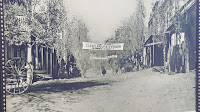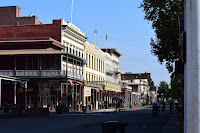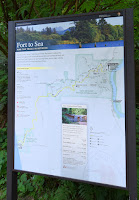Okay, for all of you who have local roots in the Puget
Sound, please do not judge me too harshly for this. But after living in western
Washington for cumulatively a couple of decades, I had never visited
Snoqualmie Falls. No excuses, other than most of the time we lived on the west side of the
sound and just never made it a destination trip. So now that we are living on
the east side of Lake Washington, we finally drove up for a look-see. Unfortunately,
it was Martin Luther King, Jr. Day and quite a few other folks decided to
join us. But more about that later.
Okay, for those of you unfamiliar with the Pacific
Northwest, Snoqualmie Falls is a 268-foot waterfall on the Snoqualmie River,
between the cities of Fall River and Snoqualmie, Washington. Perhaps it is
easier to visualize if I just tell you that from downtown Seattle, get on eastbound Interstate 90 and drive for about fifty minutes and you will run right
into it. There is free parking, a gift shop, a nice lodge, and a 1.4-mile round trip hiking path that runs from the upper viewing area down to a lower viewing
platform. Of course, the real star is the falls themselves. They are beautiful year-round,
but I gather that some dedicated individuals drive up there after a few days of
heavy rain to get a view of the falls on steroids.
The falls have been a spiritual site for Native Americans for
thousands of years. The Snoqualmie Tribe, a subgroup of the Coastal Salish
people, would gather at the falls each year for trade. (
See the official website for a complete history.) Anglo-American settlers moved into the area
after the middle of the nineteenth century. Soon after came industrialization. The 1870s brought logging operations. The 1880s brought a town and a railroad. The
1890s brought a hydro-electric powerplant still operating today.
On the day we visited it was light overcast with no rain. A
great weather day for January in Seattle. But do bring a rain jacket even if
there is no rain forecast. The falls create their own mist. We arrived about 11
am, kind of late for us early risers, but still, we made it just as the parking
lot was filling up. By 12:30, people were trawling for parking spaces. The view
from the upper area where the
Salish Lodge and the gift shop are located is
great, so if you are not in the best of shape, there is no need to see the
falls from the lower viewing area. There is a lower parking lot now open, so
look for that on the map if you like. The hike down to the lower viewing
platform is only a 0.7-mile walk. But it is a little steep and you’ll need your
breath climbing the 250 feet back up to the upper parking lot.
We are still working with COVID-19 restrictions and I was
happy to see that although viewing the falls is an outdoor activity, a vast
majority of people were wearing their masks and doing their best to stay
socially distanced. That social distancing was easily accomplished up top and
on the trail down. But as you get to the bottom, the trail narrows to a
boardwalk that goes past the old 1911 powerplant building and out to a viewing
platform. Unfortunately, when we got down there, it was busy. A crowd that
could stay distanced in the upper viewing area could not on the sidewalk-width
of the boardwalk. Folks were patient and queued up nose-to-back along the
boardwalk waiting for their turn to go out onto the viewing platform. But that’s
not the point.
Everyone was cooperating and waiting their turn. That was
great. But there was no guide or park ranger (this is not a state or national park) to keep people distanced. And hardly anyone would have seen this situation as dangerous while we are fighting a pandemic. We
decided it was not worth it and left the line after about a minute when we
realized that it could very well be a “super spreader.” I am writing that
tongue-in-cheek, but it is true. Sheila and I both have had the “
Rona”
virus as some of my students call it. Trust me. You do not want it. And we didn’t
want to get it again.
Enjoy the pictures and videos. Stop by and see Snoqualmie Falls when
you are driving from Spokane to Seattle. It is worth the stop. Look at the Falls
and think of a much longer history that you are seeing. And double-down on those
protocols: mask, wash hands, stay distanced. The only way to get through the
pandemic is with a little dose of discipline and good judgment.























































